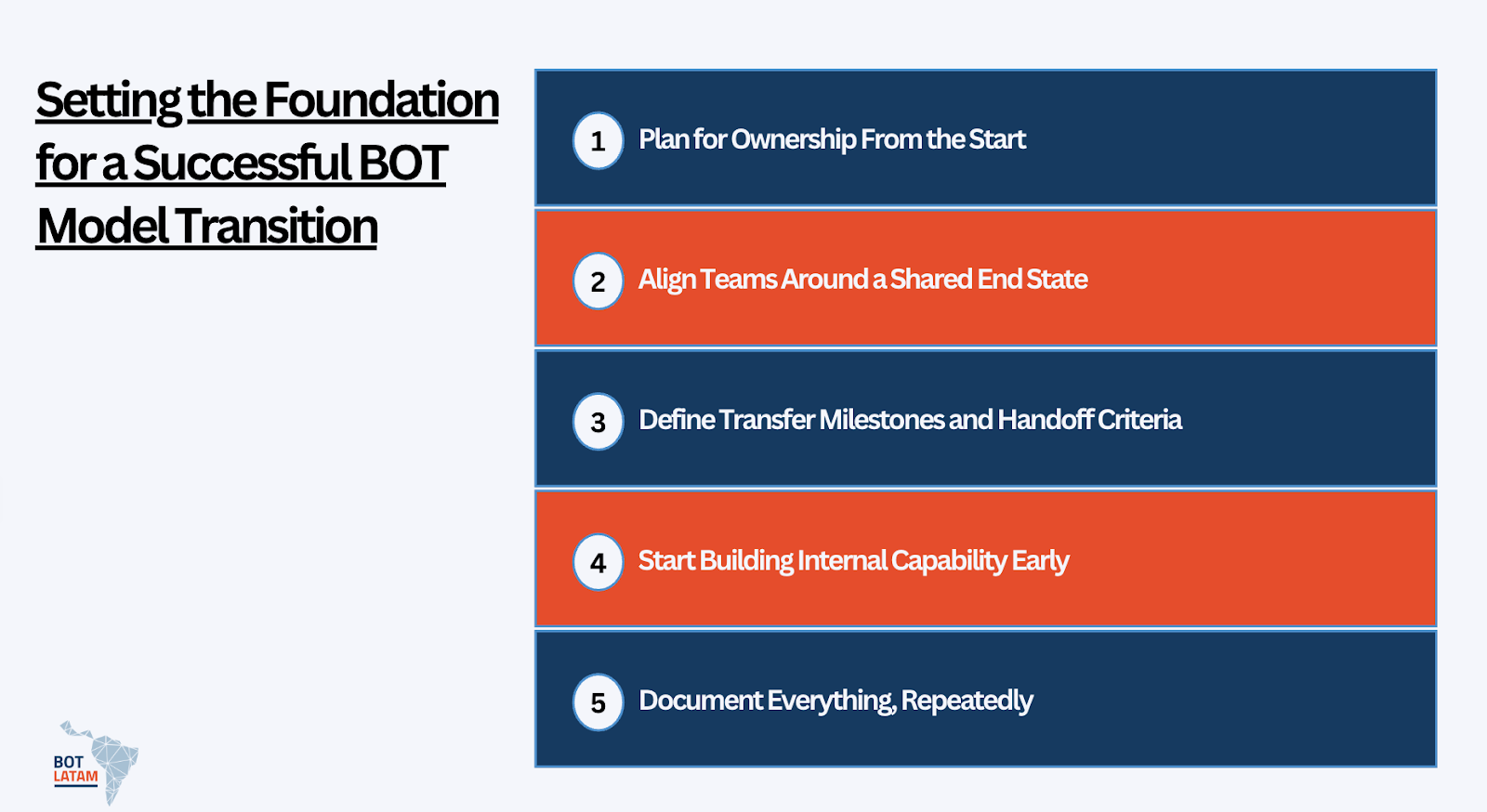Transitioning to full ownership during a Build-Operate-Transfer (BOT) agreement isn’t something you leave to chance. It’s a complex shift that affects your operations, talent, technology stack, and long-term growth. If not handled with precision, delays and misalignment can cost you more than just time.
This guide breaks down how to make that transition smooth and secure, from understanding BOT contract components to implementing a successful knowledge transfer plan. You’ll learn what to include in your agreement, how to manage the transition roadmap, and what success looks like post-handover.
More companies are leaning into the BOT model to scale internationally. In fact, according to Deloitte, 65% of global businesses use some form of outsourcing to boost performance and reduce costs. A well-structured BOT agreement can offer the control of in-house teams with the speed of external development, if you know how to manage the final handover.
Here’s what it takes to get it right.
BOT Contract Agreement Components You Should Know
When structuring a Build-Operate-Transfer contract, clarity and precision are non-negotiable. A well-written agreement doesn’t just protect your interests, it sets the operational tone for the entire lifecycle of the partnership. Each component must be aligned with your goals for performance, control, compliance, and eventual ownership.
Project Scope and Deliverables.
Clearly define what the vendor is responsible for during each phase—build, operate, and transfer. This includes team setup, infrastructure provisioning, technology stack, timelines, and KPIs. Scope creep can become a real issue in long-term engagements. To avoid that, use fixed deliverables with time-bound milestones, along with documented change request protocols.
Ownership and Intellectual Property (IP) Rights.
Spell out IP ownership early. You don’t want to discover at the end of the project that critical code or systems don’t legally belong to you. Ensure the contract specifies that all code, documentation, tools, and infrastructure will transfer to your ownership at a clearly defined handover point. According to WIPO, IP-related disputes make up nearly 30% of international outsourcing disagreements. Don't leave this vague.
Handover and Transition Milestones.
Your contract should include a detailed transition timeline and checklist. Include measurable handover stages like codebase delivery, knowledge transfer sessions, and infrastructure access. Define how success is measured at each phase, this will reduce friction during the move to full ownership.
Confidentiality and Data Security.
Data security must be treated as a core obligation, not an afterthought. Include clauses related to NDAs, compliance with international standards (such as ISO 27001), and legal jurisdiction. If you’re working across borders, clarify how data residency laws will be handled.
Governance and Communication Framework.
Build a governance model directly into the contract. This means outlining communication frequency, escalation paths, and decision-making responsibilities. A common mistake is assuming alignment will “just happen.” Create joint steering committees with shared visibility on deliverables and risks from the start.
Payment Terms and Cost Transparency.
Include a cost breakdown for each BOT phase. List one-time setup fees, operational costs, and transition-related expenses. If bonuses or penalties are tied to milestones, define them clearly. According to KPMG, 48% of failed outsourcing projects cite poor financial transparency as a root cause.
Service Level Agreements (SLAs).
Operational expectations need teeth. Use SLAs to define uptime, response times, bug resolution windows, and support levels. Make sure there are enforceable penalties for non-compliance. This ensures your vendor stays accountable from build to transfer.
Exit Clauses and Contingency Scenarios.
A strong BOT agreement includes clearly defined exit options. What happens if the vendor underperforms? What if market conditions change? Add a contingency plan that outlines early termination conditions, knowledge preservation steps, and financial consequences.
Setting the Foundation for a Successful BOT Model Transition

A smooth transition during a Build-Operate-Transfer (BOT) model doesn’t start at the handover phase, it starts on day one. Laying the groundwork early is what separates successful transitions from costly, drawn-out handovers. The key is to embed transition readiness into the build and operate stages from the beginning.
1. Plan for Ownership From the Start
Every BOT agreement should be designed with the transfer phase in mind. That means defining long-term ownership goals before any work begins. Establish internal roles for eventual team integration, technical infrastructure compatibility, and leadership continuity. Planning early helps reduce operational disruption and knowledge gaps when the switch happens.
2. Align Teams Around a Shared End State
You need clear alignment between your internal team and the vendor’s delivery team. This includes shared visibility into long-term strategy, not just short-term tasks. According to PwC, 39% of failed outsourcing transitions are due to mismatched expectations between stakeholders. Establish a shared vision early, reinforced through regular cross-functional meetings and documented OKRs.
3. Define Transfer Milestones and Handoff Criteria
Your contract may outline timelines, but your team needs detailed operational milestones. Create a transfer-readiness checklist covering technical documentation, codebase maturity, tooling access, infrastructure handoff, and security protocols. Include validation points like code audits, system stress tests, and redundancy reviews.
4. Start Building Internal Capability Early
Don't wait for the last six weeks to hire or upskill internal staff. Bring in key personnel during the operate phase so they can shadow the vendor team and absorb institutional knowledge. This phased onboarding reduces ramp-up time and ensures fewer gaps during the transfer. According to Deloitte’s Global Outsourcing Survey, companies that gradually internalize talent before the transfer see 31% faster post-handover stabilization.
5. Document Everything, Repeatedly
Institutional knowledge loss is one of the biggest risks in BOT transitions. Create and maintain living documentation throughout the lifecycle, don’t push it to the end. This should include architecture diagrams, SOPs, process flows, escalation protocols, and QA benchmarks. Utilize centralized knowledge platforms with access controls to maintain current and secure information.
Key Success Factors for BOT Transition
The transfer phase of a Build-Operate-Transfer model is where risk concentrates. To make it work, you need more than a handover checklist. Success depends on how well people, processes, and systems align in real time, without disruption, delay, or confusion. Here’s what matters most when navigating the transition to the BOT model.
Structured Knowledge Transfer:
You can't transfer ownership without transferring expertise. Start documenting everything, including technical specs, user flows, and infrastructure maps, well before the handover date. Make knowledge-sharing sessions mandatory across teams and functions. Use recorded walkthroughs, paired sessions, and playbooks. According to McKinsey, 45% of operational challenges during outsourcing transitions stem from poorly managed knowledge handoffs. The earlier the ramp-up, the smoother the transition.
Internal Talent Readiness:
Your internal team must be fully capable before full control lands on their plate. That means upskilling early, not scrambling later. Assign key personnel to shadow vendor teams during the operate phase. Include engineers, product managers, QA leads, and security stakeholders. When internal teams are trained on live systems, transfer downtime drops significantly.
Consistent Leadership and Change Management:
The transfer isn’t just technical, it’s cultural. Leadership should actively manage expectations, remove blockers, and reinforce alignment between external and internal teams. A well-planned change management approach increases stakeholder buy-in, reduces churn, and supports momentum. Gartner reports that 70% of large-scale transitions fail due to a lack of organizational alignment, not technical errors.
Documentation Ownership:
Documentation should be treated as a deliverable, not a formality. This includes code documentation, standard operating procedures, decision logs, runbooks, escalation paths, and architecture diagrams. Everything must be version-controlled, accessible, and validated by internal stakeholders. The goal is to eliminate tribal knowledge and make operational continuity a given.
Communication Cadence:
Daily standups may not be enough. Set a formal communication cadence that spans leadership, product, ops, and engineering. Include milestone reviews, transition-specific syncs, and risk status updates. Transparency builds trust and allows faster intervention when gaps appear.
Technology Standardization:
If the vendor used tools, frameworks, or workflows not aligned with your internal systems, you'll run into friction. Standardize tooling during the operate phase. Use your long-term tech stack, CI/CD pipelines, testing environments, and monitoring platforms early, so the transition doesn’t require a parallel migration.
Post-Transfer Support Window:
Success doesn’t stop at handover. Build in a defined post-transfer support period, ideally 30 to 90 days. The vendor should provide reactive and proactive support, including bug resolution, minor optimizations, and handholding for critical releases. It acts as a safety net while your team gets fully comfortable.
Risk and Contingency Planning:
You need a fallback plan. What if the handover date slips? What if the vendor under-delivers? Include tiered risk assessments and phased backup plans in your transition strategy. Use real-time dashboards to monitor transition health across functions and escalate early.
Ready To Transition To BOT?
Transitioning to full ownership under a BOT agreement is where strategic planning meets operational reality. Without clear processes, defined roles, and early alignment, the final handover can turn into a costly delay instead of a growth milestone.
At BOT LATAM, we’ve helped fast-scaling companies across the Americas navigate this exact shift, ensuring operational continuity, protecting IP, and accelerating ownership readiness. Our team specializes in structuring BOT models with clear transfer milestones, compliant frameworks, and built-in transition protocols that match your internal capabilities. With many successful transitions managed across industries, we bring experience, regional expertise, and execution precision to every project.
If you're preparing to scale or move from operation to ownership in Latin America, we’re here to help you get it right the first time. Contact us!

Revolutionize Your Workflow with Our Innovative BOT Strategy!
Enhance your operations seamlessly and adapt to market demands
Contact Us



%2017.26.38.png)
